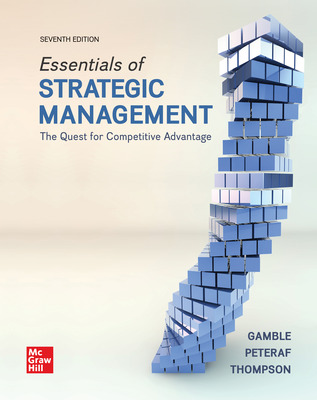Essentials of Strategic Management The Quest for Competitive Advantage 7th Edition Gamble – Test Bank
$35
Description
Essentials of Strategic Management The Quest for Competitive Advantage 7th Edition Gamble – Test Bank
Chapter 01
Strategy, Business Models, and Competitive Advantage
Multiple Choice Questions
1. Managers in all types of businesses must address the central strategic question:
A. Where are we now?
B. Where do we want to go from here?
C. How are we going to get there?
D. When will we know we are there?
E. All of these
2. A company’s strategy consists of
A. actions to develop a more appealingbusiness model than rivals.
B. plans involving alignment of organizational activities and strategic objectives.
C. offensive and defensive moves to generate revenues and increase profit margins.
D. competitive moves and approaches that managers have developed to grow the business, attract and please customers, conduct operations, and achieve targeted objectives.
E. its strategic vision, its strategic objectives, and its strategic intent.
Copyright © 2015 McGraw-Hill Education. All rights reserved. No reproduction or distribution without the prior written consent of
McGraw-Hill Education.
3. The competitive moves and business approaches a company’s management is using to grow the business, compete successfully, attract and please customers, conduct operations, respond to changing economic and market conditions, and achieve organizational objectives is referred to as its
A. strategy.
B. mission statement.
C. strategic intent.
D. business model.
E. strategic vision.
4. A company’s strategy is most accurately defined as
A. management’s approaches to building revenues, controlling costs, and generating an attractive profit.
B. management’s game plan for growing the business, attracting and pleasing customers, conducting operations, and achieving financial and market performance objectives.
C. management’s concept of “where we are headed.”
D. the business model that a company’s board of directors has approved for outcompeting rivals and making the company profitable.
E. the choices management has made regarding what financial plan to pursue.
5. Which of the following is not something a company’s strategy is concerned with?
A. Management’s choices about how to attract and please customers
B. Management’s choices about how quickly and closely to copy the strategies being used by successful rival companies
C. Management’s choices about how to grow the business
D. Management’s choices about how to outcompete rivals
E. Management’s action plan for conducting operations and improving the company’s strategic and financial performance
6. Which of the following is not an element of a company’s business strategy?
A. Actions to respond to changing market conditions or other external factors
B. Actions to strengthen competitiveness via strategic alliances and collaborative partnerships
C. Actions to strengthen internal capabilities and competitively valuable resources
D. Actions to manage the functional areas of the business
E. Management actions to revise the company’s financial and strategic performance targets
7. Which of the following is an issue likely to be addressed by a company’s business strategy?
A. Actions to respond to changing economic and market conditions.
B. Actions to supplement the company’s resources and capabilities through alliances and joint ventures.
C. Reactions to offensive moves by rival sellers.
D. Actions and approaches used in managing the functional areas of the business.
E. All of these are pertinent in identifying a company’s strategy.
8. The most important aspect(s) of a company’s business strategy
A. are the actions and moves in the marketplace that managers take to gain a sustainable competitive advantage.
B. is figuring out how to maximize profits and shareholder value.
C. concerns how to improve the efficiency of its business model.
D. deals with how management plans to maximize profits while, at the same time, operating in a socially responsible manner.
E. is figuring out how to become the industry’s low-cost provider.
1-4
9. A creative, distinctive strategy that delivers a sustainable competitive advantage is important because
A. without a proven strategy a company is likely to fall into bankruptcy.
B. without a competitive advantage a company cannot have a profitable business model.
C. a strategy that yields a competitive advantage over rivals is a company’s most reliable means of achieving above-average profitability and financial performance.
D. a competitive advantage is what enables a company to achieve its strategic objectives.
E. how a company goes about trying to please customers and outcompete rivals is what enables senior managers to choose an appropriate strategic vision for the company.
10. A company achieves sustainable competitive advantage when
A. it has a profitable business model.
B. a sufficiently large number of buyers have a lasting preference for its products or services as compared to the offerings of competitors.
C. it is able to maximize shareholder wealth.
D. it is consistently able to achieve both its strategic and financial objectives.
E. its strategy and its business model are well-matched and in sync.
You must be logged in to post a review.



Reviews
There are no reviews yet.